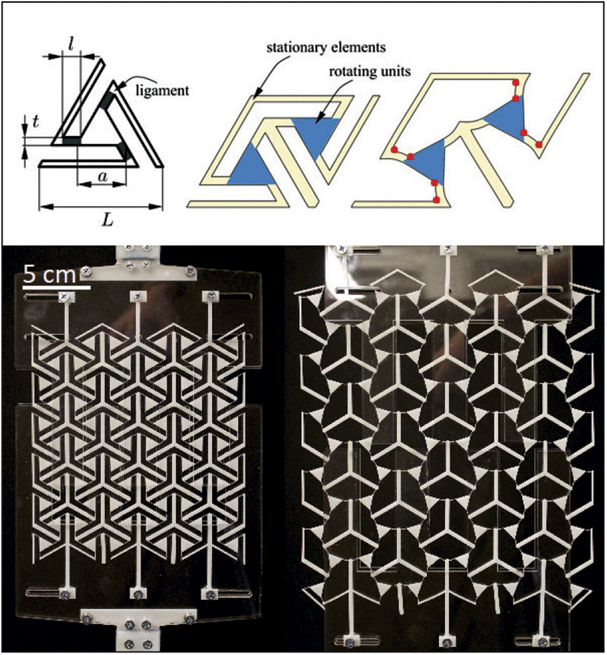Arigid polymer, showing elastic-perfectly plastic behavior that resembles that of metals, has been added to the family of bistable auxetic metamaterials (BAMs). These materials expand when compressed from their initial configuration to a new state of equilibrium. Researchers at McGill University in Montreal have altered the micro-architecture of a common rigid polymer to create a metamaterial with high mechanical performance that is able to withstand at least 10,000 cycles of use. Their work, published in a recent issue of the Journal of Materials Research (doi: 10.1557/jmr.2017.417), expands the selection of raw materials for BAMs to rigid solids, and is thereby widening the choice available for applications like solar panels, turbo engines, and even medical stents.

Above, the geometry of the building blocks (left) and a unit cell in its closed and open state (right). The red dots show the points where the optimization of the sharp ligament edges took place. Below, a BAM sample with 6 × 6 units fabricated from Delrin® Acetal Resin in its undeformed (left) and fully open (right) configuration. The sample is sandwiched between two Plexiglas plates to prevent out-of-plane deformation during tensile testing. The 6 × 6 units were chosen because this number of units proved capable of providing BAM with a smooth and reversible opening and closing. Credit: Damiano Pasini.
Like an umbrella that can open, close, and remain stable and functional in both states, an undeformed BAM undergoes a smooth and fully reversible shape and size transformation when put under tension. In contrast to non-auxetic materials, a BAM grows, exhibiting a negative Poisson ratio, and reaches a second state of equilibrium. When the tension is removed, the material returns to its initial state. As is usually the case in metamaterials, both auxeticity and bistability are governed by the material structure rather than the chemical composition.
After establishing a successful design for BAM elastomers last year, Damiano Pasini and his students at McGill University decided to test their pattern on rigid solids, which can offer high melting and softening temperatures along with higher strength and stiffness. They chose Delrin® Acetal Resin as the rigid polymer, and created monolithic samples based on kirigami architecture out of 1.6-mm- thick polymer sheets. Kirigami is related to the origami folding tradition; apart from folds, it also incorporates cuts and apertures.
“We tried to stretch the material and it broke straight away,” Pasini says. A need for modification of the original pattern became evident to ensure that the polymer could sustain repeated cycles of opening and closure. The new design developed by the team and cut using a CO2 laser cutter is based on rectangular stationary elements and equilateral triangular rotating units, which do not deform when pulled. Larger openings are introduced between the basic units that are connected with slender ligaments. It was these ligaments that kept breaking as the structure opened and closed. To get around this problem, the ligament geometry was tailored in order to smooth stress peaks localized in the ligaments.
Performance, bistability, and durability of the rigid BAMs were assessed, and the experiments confirmed the numerical simulations. To study bistability and failure conditions, nonlinear numerical analyses were performed on models pulled uniaxially until full expansion. BAM unit-cell samples were also tested under large displacement control using a Bose ElectroForce tester.
“We can open and close the structure this monolithic architected material has been shaped into for at least 10,000 times and the functionality is preserved,” Pasini says.
“This is a record-breaking resistance to fracture, in lattices undergoing such large local deformations!” says Chiara Daraio, professor of aeronautics and applied physics at the California Institute of Technology. Daraio believes that the work presented by Pasini and his team makes a leap forward in the possible application of mechanical metamaterials in engineering systems. “The authors showed a clever and elegant design strategy, to ensure the durability of bistable lattices in response to repeated loading, by using optimized ligaments for the connection of different geometrical units,” she adds.
Dennis Kochmann, professor of mechanics and materials at ETH Zürich, thinks that the link established between phase transformations in materials and the periodic unit-cell design in this metamaterial is intriguing. “This new structural design paradigm exploits the smart combination of stiff elements and compliant connectors to achieve what is a rare find among natural materials: large, reversible deformation,” he says, adding that “the computational exploration of the design space highlights how the same approach can be utilized to devise a wide range of material behavior at the structural, metamaterial level.”
Having as a starting point the same design approach, the team is now planning to explore whether bistabillity and auxeticity can be combined in fragile, brittle metamaterials made of glass.


